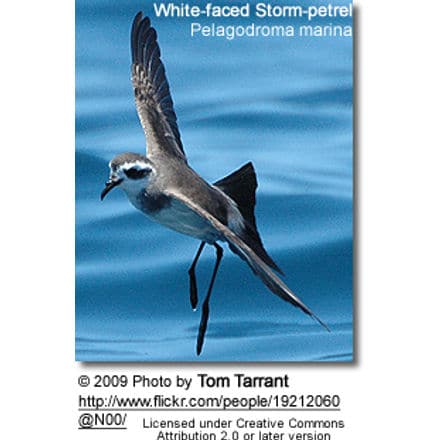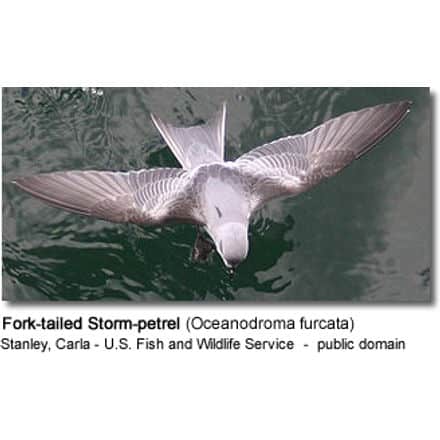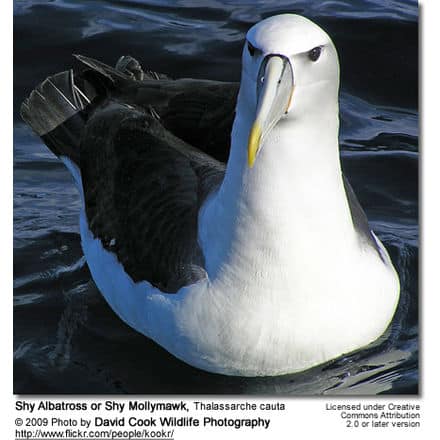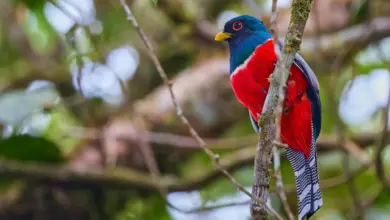Storm Petrels
Storm petrels are seabirds in the family Hydrobatidae, part of the order Procellariiformes.
These smallest of seabirds feed on planktonic crustaceans and small fish picked from the surface, typically while hovering. The flight is fluttering and sometimes bat-like.
Species of Storm-petrels

Storm-petrels are seabirds in the family Hydrobatidae, part of the order Procellariiformes.
These smallest of seabirds feed on planktonic crustaceans and small fish picked from the surface, typically while hovering. The flight is fluttering and sometimes bat-like.
Storm-petrels have a cosmopolitan distribution, being found in all oceans. They are strictly pelagic, coming to land only when breeding. In the case of most species, little is known of their behaviour and distribution at sea, where they can be hard to find and harder to identify.
They are colonial nesters, displaying strong philopatry to their natal colonies and nesting sites. Most species nest in crevices or burrows and all but one species attends the breeding colonies nocturnally. Pairs form long term monogamous bonds and share incubation and chick feeding duties. Like many species of seabird nesting is highly protracted with incubation taking up to 50 days and fledging another 70 days after that.
Several species of storm-petrel are threatened by human activities. One species, the Guadalupe Storm-petrel, is thought to have gone extinct; the New Zealand Storm-petrel was presumed extinct until rediscovered in 2003. The principal threats to storm-petrels are introduced species, particularly mammals, in their breeding colonies; many storm-petrels habitually nest on isolated mammal free islands and are unable to cope with predators like rats and feral cats.
Listing of Species with links to informational pages and photos

Storm-petrels are the smallest of all the seabirds, ranging in size from 13-26 cm in length. There are two body shapes in the family; the Oceanitinae have short wings, square tails, elongated skulls, and long legs; the Hydrobatinae have longer wings, forked or wedge-shaped tails and shorter legs. The legs of all storm-petrels are proportionally longer than those of other Procellariiformes, but they are very weak and unable to support the bird’s weight for more than a few steps.
The plumage of the Oceanitinae is dark with white underparts (with the exception of the Wilson’s Storm-petrel) All but two of the Hydrobatinae are mostly dark in colour with varying amounts of white on the rump. Two species have different plumage entirely, the Hornby’s Storm-petrel which has white undersides and facial markings, and the Fork-tailed Storm-petrel which has pale grey plumage. This is a notoriously difficult group to identify at sea.
Onley and Scofield (2007) state that much published information is incorrect, and that photographs in the major seabird books and websites are frequently incorrectly ascribed as to species. They also consider that several national bird lists include species which have been incorrectly identified or have been accepted on inadequate evidence.
Storm-petrels use a variety of techniques to aid flight. Most species will occasionally feed by surface pattering, holding and moving their feet on the water’s surface while holding steady above the water. They remain stationary by hovering with rapid fluttering or by using the wind to anchor themselves in place. This method of feeding flight is most commonly used by Oceanitinae storm-petrels.
The White-faced Storm-petrel possesses a unique variation on pattering, holding its wings motionless and at an angle into the wind it pushes itself off the water’s surface in a succession of bounding jumps. Storm-petrels also use dynamic soaring and slope soaring to travel over the ocean surface.
Dynamic soaring is used mostly by the Hydrobatinae, gliding across wave fronts gaining energy from the vertical wind gradient. Slope soaring is more straightforward and favoured by the Oceanitinae, the storm-petrel turns to the wind, gaining height, from where it can then glide back down to the sea.
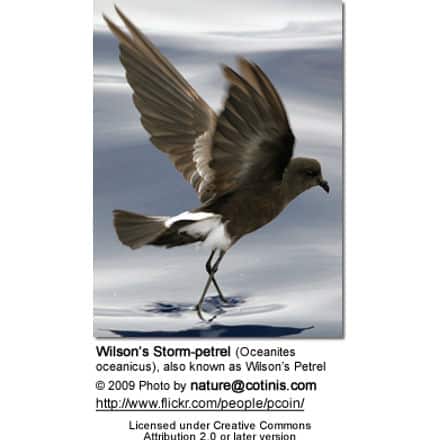
The diet of may storm-petrels species is poorly known due to difficulties in researching; overall the family is though to concentrate on crustaceans. Small fish, oil droplets and mollusks are also taken by many species. Some species are known to be rather more specialised; the Grey-backed Storm-petrel is known to concentrate on the larvae of goose barnacles.
Almost all species forage in the pelagic zone (open sea), except for the White-vented Storm-petrels which are coastal feeders in the Galapagos Islands. Although storm-petrels are capable of swimming well and often form rafts on the water’s surface they do not feed on the water.
Instead feeding usually takes place on the wing, with birds hovering above or ‘walking’ on the surface (see morphology) and snatching small morsels. Rarely prey is obtained by making shallow dives under the surface.
Like many seabirds storm-petrels will associate with other species of seabird and marine mammal species in order to help obtain food. It is theorised that they benefit from the actions of diving predators such as seals and penguins which push prey up towards the surface while hunting allowing the surface feeding storm-petrels to reach them.
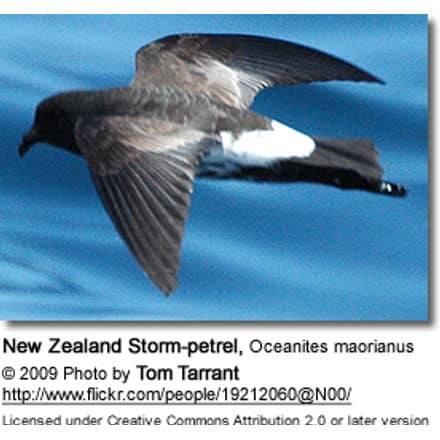
Storm-petrels are found in all the world’s oceans and in most of its seas. They are absent as breeders from the western Indian Ocean and as regular migrants or residents from the far north of the Arctic Ocean as well as the eastern extents of the Mediterranean, the Black Sea and areas of brackish water. The Oceanitinae are typically found in the southern hemisphere and the Hydrobatinae in the northern hemisphere.
Several species of storm-petrel undertake migrations after the breeding season. The most widely travelled migrant is the Wilson’s Storm-petrel which after breeding in Antarctica and the subantarctic islands regularly crosses the equator to the waters of the north Pacific and Atlantic.
Other species undertake migrations of differing lengths; long ones, such as the Swinhoe’s Storm-petrel, which breeds in the west Pacific and migrates to the west Indian Ocean; and other seabirds in the or shorter ones, such as the Black Storm-petrel which nests in southern California and migrates down the coast of Central America as far south as Colombia.
Some species, like the Tristram’s Storm-petrel or the Grey-backed Storm-petrel are thought to be essentially sedentary and not undertake any migrations away from their breeding islands.
Breeding
Storm-petrels nest colonially, for the most part on islands; although a few species breed on the mainland, particularly Antarctica.
Nesting sites are attended nocturnally in order to avoid predators;although the Wedge-rumped Storm-petrels nesting in the Galapagos Islands are the exception to this rule and attend their nesting sites during the day.
Storm-petrels display high levels of philopatry, returning to their natal colonies to breed. In one instance a Band-rumped Storm-petrel was caught as an adult 2m from its natal burrow.
Storm-petrels nest either in burrows dug into soil or sand, or in small crevices in rocks and scree. Competition for nesting sites is intense in colonies where storm-petrels compete with other burrowing petrels, with shearwaters having been recorded killing storm-petrels in order to occupy their burrows.
Colonies can be extremely large and dense; 840,000 pairs of White-faced Storm Petrel nest on South East Island in the Chatham Islands in burrow densities of between 1.18 – 0.47 burrows/m²; densities as high as 8 pairs/m² for Madeiran Storm-petrels in the Galapagos and colonies 3.6 million strong for Leach’s Storm Petrel have been recorded.
Storm-petrels are monogamous and form long-term pair bonds that last a number of years. Studies of paternity using DNA fingerprinting have shown that, unlike many other monogamous birds, infidelity (extra-pair matings) is very rare.
As with the other Procellariiformes, a single egg is laid by a pair in a breeding season; if the egg fails, then usually no attempt is made to relay (although it happens rarely). Both sexes incubate in shifts of up to six days. The egg hatches after 40 or 50 days; the young is brooded continuously for another 7 days or so before being left alone in the nest during the day and fed by regurgitation at night.
Meals fed to the chick weigh around 10-20% of the parent’s body weight, and consist of both prey items and stomach oil. Stomach oil is an energy rich (its calorific value is around 9600 calories per gram) oil created by partly digested prey in a part of the foregut known as the proventriculus.
By partly converting prey items into stomach oil storm-petrels can maximise the amount of energy chicks receive during feed, an advantage for small seabirds that can only make a single visit to the chick during a 24 hour period (at night).
The average age at which chicks fledge depends on the species, taking between 50 or 70 days. The time taken to hatch and raise the young is long for the bird’s size but is typical of seabirds, which in general are K-selected, living much longer, delay breeding for longer, and invest more effort into fewer young. Storm-petrels have been recorded living as long as 30 years.
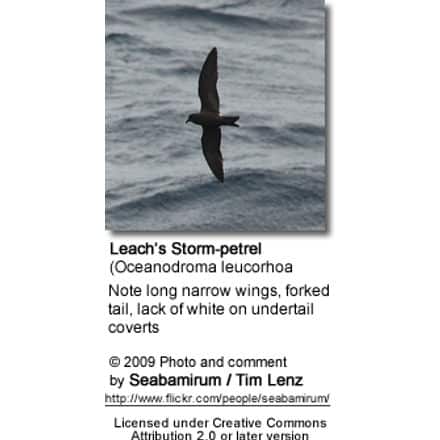
Several species of storm-petrel are threatened by human activities. Two, the Guadalupe Storm-petrel, and the New Zealand Storm-petrel, are listed as critically endangered. The Guadalupe Storm-petrel has not been observed since 1906 and most authorities consider it extinct.
The New Zealand Storm-petrel was also considered extinct for many years but was sighted again in 2003, though the population is likely to be very small. One species (the Ashy Storm-petrel) is listed as endangered due to a 42% decline over twenty years, and two other species are also listed as near threatened or worse.
In addition four species are so poorly known that they are listed as data deficient. For two species, the recently rediscovered New Zealand Storm-petrel and the Ringed Storm-petrel, even the sites of their breeding colonies remain a mystery.
Storm-petrels face the same threats as other seabirds, in particular they are threatened by introduced species. The Guadalupe Storm-petrel was driven to extinction by feral cats, and introduced predators such as have also been responsible for declines in other species.
Habitat degradation which limits nesting opportunities caused by introduced goats and pigs is also a problem, especially if it increases competition from more aggressive burrowing petrels.
Cultural representation of the storm-petrel
The name “petrel” is a diminutive form of “Peter”, a reference to Saint Peter; it was given to these birds because they sometimes appear to walk across the water’s surface. The more specific ‘storm petrel’ or ‘stormy petrel’ is a reference to their habit of hiding in the lee of ships during storms.
Early sailors named these birds “Mother Carey’s Chickens” because they were thought to warn of oncoming storms; this name is based on a corrupted form of Mater Cara, a name for the Blessed Virgin Mary.
Breton folklore holds that storm-petrels are the spirits of sea-captains who mistreated their crew, doomed to spend eternity flying over the sea, and they are held to be the souls of drowned sailors; sinister names from Britain and France include Waterwitch, satanite, satanique and oiseau du diable.
The “stormy petrel” appears as the standard English translation of the name of the lead character in Song of the Stormy Petrel – a 1901 poem by the Russian revolutionary writer Maxim Gorky in which he turned to the imagery of Subantarctic avifauna to describe Russian society’s attitudes to the coming revolution. This poem was called “the battle anthem of the revolution”, and earned Gorky himself the title of “The Storm Petrel of the Revolution”.
While this English translation of the bird’s name may be ornithologically incorrect (the Russian burevestnik refers to many Procellariiformes species, but not to any Hydrobatidae), it is poetically appropriate, as burevestnik literally means “the announcer of the storm”.
Taxonomy
Two subfamilies are traditionally recognized. The Oceanitinae are mostly found in southern waters (though the Wilson’s Storm-petrel regularly migrates into the northern hemisphere); there are 7 species in 5 genera. The Hydrobatinae are the two genera Hydrobates and Oceanodroma. They are largely restricted to the northern hemisphere, although a few can visit or breed a short distance beyond the equator.
cytochrome b DNA sequence analysis suggests that the family is paraphyletic and may be more accurately treated as distinct families. The same study found that the storm-petrels are certainly ancestral to the Procellariiformes.
The first split was the subfamily Hydrobatinae, with the Oceanitinae splitting from the rest of the order at a later date. Few fossil species have been found, with the earliest being from the Upper Miocene.
Species of Storm-petrels – Family Hydrobatidae
| Subfamily | Common name | Scientific name | Status |
|---|---|---|---|
| Oceanitinae | Wilson’s Storm-petrel | Oceanites oceanicus | extant |
| New Zealand Storm-petrel | Oceanites maorianus | extant | |
| White-vented Storm-petrel | Oceanites gracilis | extant | |
| Grey-backed Storm-petrel | Garrodia nereis | extant | |
| White-faced Storm-petrel | Pelagodroma marina | extant | |
| Black-bellied Storm-petrel or Gould’s Storm-Petrel | Fregetta tropica | extant | |
| White-bellied Storm-petrel | Fregetta grallaria | extant | |
| Polynesian Storm-petrel (including “White-throated Storm-petrel”) | Nesofregetta fuliginosa | extant | |
| Hydrobatinae | European Storm-petrel | Hydrobates pelagicus | extant |
| Leach’s Storm-petrel | Oceanodroma leucorhoa | extant | |
| Matsudaira’s Storm-petrel | Oceanodroma matsudairae | extant | |
| Least Storm-petrel | Oceanodroma microsoma | extant | |
| Wedge-rumped Storm-petrel | Oceanodroma tethys | extant | |
| Madeiran Storm-petrel | Oceanodroma castro | extant | |
| Monteiro’s Storm-petrel | Oceanodroma monteiroi | extant | |
| Swinhoe’s Storm-petrel | Oceanodroma monorhis | extant | |
| Guadalupe Storm-petrel | Oceanodroma macrodactyla | extinct | |
| Tristram’s Storm-petrel | Oceanodroma tristrami | extant | |
| Markham’s Storm-petrel | Oceanodroma markhami | extant | |
| Black Storm-petrel | Oceanodroma melania | extant | |
| Ashy Storm-petrel | Oceanodroma homochroa | extant | |
| Hornby’s Storm-petrel | Oceanodroma hornbyi | extant | |
| Fork-tailed Storm-petrel | Oceanodroma furcata | extant |
Copyright: Wikipedia. This article is licensed under the GNU Free Documentation License. It uses material from Wikipedia.org

